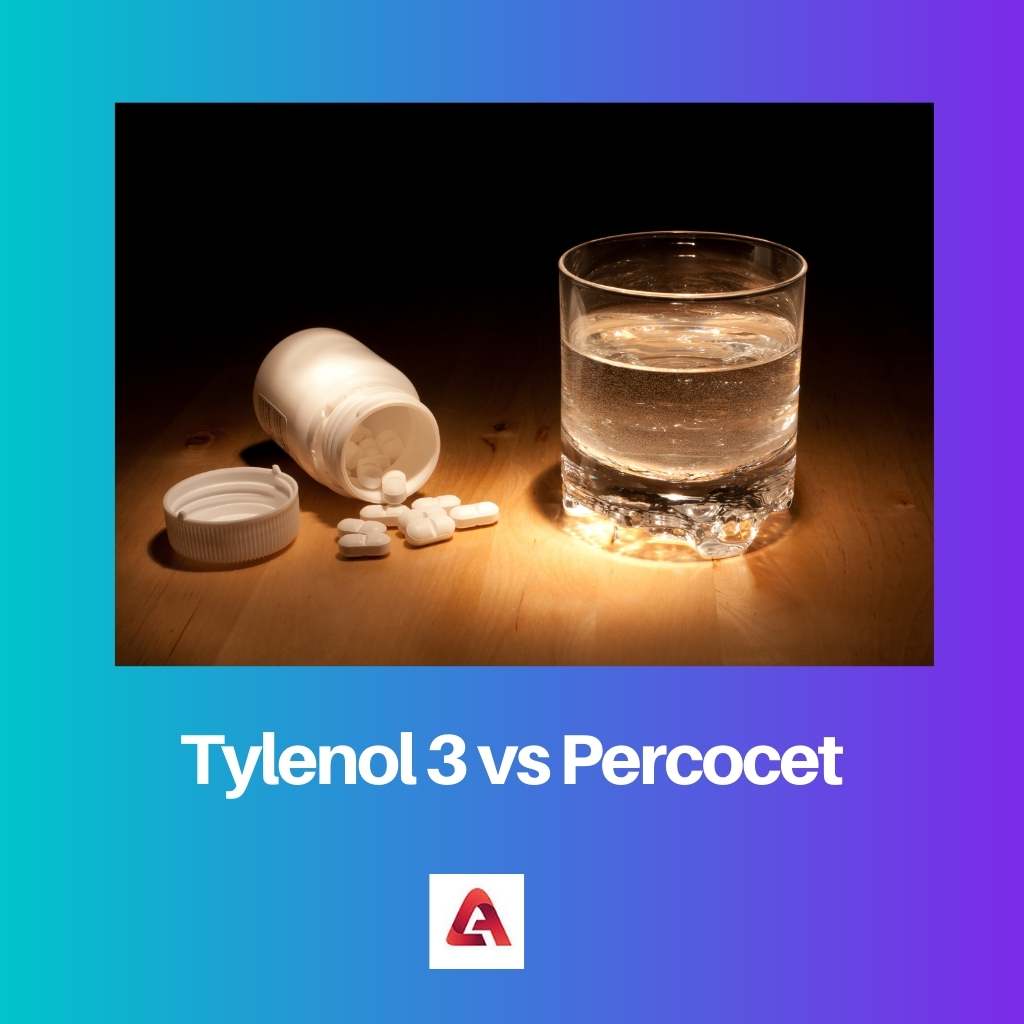Drugs are chemical substances that can affect an individual’s physical as well as mental state. Drugs affect a person’s senses diversely, which is later depicted through an individual’s behaviour, way of speech, and body language, etc.
Not all drugs are exploited for drug abuse. Drugs are consumed in a prescribed amount by doctors for certain health illnesses too. Tylenol 3 and Percocet are the two drugs among many.
Key Takeaways
- Tylenol 3 contains a combination of acetaminophen and codeine, while Percocet combines acetaminophen with oxycodone.
- Tylenol 3 is prescribed for moderate pain, whereas Percocet is used for moderate to severe pain management.
- Both medications risk dependency and side effects, but Percocet carries a higher potential for addiction due to oxycodone’s potency.
Tylenol 3 vs Percocet
Tylenol 3 contains codeine, which is a mild opioid, and acetaminophen. It’s used to treat mild to moderate pain, such as headaches, dental pain, and menstrual cramps. Percocet contains oxycodone, which is a stronger opioid than codeine and acetaminophen. It is used to treat moderate to severe pain.

Tylenol 3 is a drug that can be consumed orally only under a medical prescription from a doctor. The drug is used to relieve an individual from severe to mild pain.
t is prescribed to an individual 12 years of age or older and adults. The drug has a risk of drug abuse, so it must be consumed carefully.
While Percocet is a drug and a brand name of a mixture of acetaminophen and oxycodone, the drug is an approved pain reliever by FDA.
The drug contains oxycodone, which is twice more potent than morphine. The potent drug is prescribed in low doses and is not combined with other pain relief options.
Percocet is only prescribed to an individual when a non-opioid pain killer couldn’t aid much because Percocet is easily exploited for drug abuse, so this must be consumed carefully under supervision.
Comparison Table
| Parameters of Comparison | Tylenol 3 | Percocet |
|---|---|---|
| Composition | It is made by mixing acetominophen and codeine. | It is made by mixing acetominophen and oxycodone. |
| Consumption dosage | 1 to 2 pills in every 4 hours. | 1 to 2 pills in every 6 hours. |
| Treatment | It helps in relieving mild pain. | It helps in relieving severe pain. |
| Availability | It is easily available even without a prescription. | It is not available without a medical prescription. |
| Quantity of component | It has comparatively less quantity of acetominophen. | It has comparatively 25gm of acetominophen more in quantity. |
What is Tylenol 3?
Tylenol 3 is a type of drug. The constituents of the drug are acetaminophen and codeine. The drug is widely consumed orally, only under a medical prescription from a doctor.
It is used for relieving an individual from severe to mild pain. The drug is prescribed to an individual 12 years of age or older and adults.
Tylenol 3 has a risk of drug abuse, so it must be consumed carefully. One must know certain precautions and contradictions before consuming Tylenol 3.
As codeine is a component that is present in Tylenol 3, this raises concern because codeine can cause respiratory depression and low blood oxygen levels, and in severe cases, it can be fatal too. Codeine is also present in many cough syrups.
These cough syrups affect the part of the brain called the hypothalamus, which controls the cough reflex, and therefore this is how codeine helps in lowering the coughing in children as well as adults.
Tylenol 3 might have some side effects after consumption. The most common side effects can be vomiting, nausea, drowsiness, dizziness, dry mouth, constipation, headache, shortness of breath and extreme sweating.
The least common side effects can be insomnia, fatigue, nervousness, palpitations, diarrhoea, cramps and abdominal inconvenience. In adults, a high dosage of Tylenol 3 can cause dark urine, jaundice and pale stools.
What is Percocet?
Percocet is a type of drug. The constituents of the drug are acetaminophen and oxycodone. As acetaminophen is a low potent “pain reliever” and oxycodone is a narcotic opioid “pain reliever, ” Percocet is a widely chosen pain killer.
Percocet is only prescribed to an individual when a non-opioid pain killer couldn’t aid much because Percocet is easily exploited for drug abuse, so this must be consumed carefully under supervision.
Percocet also has certain side effects on consumers. The common side effects are constipation, headache, nausea, dizziness, dry mouth, itchy eyes, blurred vision and feelings of extreme sadness or happiness.
The severe side effects can be dangerous: convulsions, urination problems, passing out, unusual bleeding and weakness, cold skin, weak pulse rate and shallow breathing.
It might even cause severe skin rashes. A person who has hives must not consume Percocet. One must avoid consuming alcohol after the consumption of Percocet as it might be fatal.
There are certain precautions to be aware of before consuming Percocet. The inactive ingredients of the drug can cause allergic reactions. The drug has the potential to cause drowsiness and dizziness. The drug can even cause hypersensitivity reactions.
An individual with a history of drug abuse must be kept away from this drug as it can overdose and cause death.
If an individual is about to have surgery or an operation, then the doctor must inform them about the history of Percocet consumption. This drug must be stored in a cold place and away from heat and moisture.

Main Differences Between Tylenol 3 and Percocet
- Tylenol 3 is easily available in a store, whereas Percocet is available only under medical prescription.
- The generic name of Tylenol 3 is acetaminophen-codeine, whereas the generic name of Percocet is oxycodone-acetaminophen.
- Tylenol 3 is a mild pain reliever, whereas Percocet is a severe pain reliever.
- Tylenol 3 has less quantity of acetaminophen, whereas Percocet has 25gm more acetaminophen in quantity.
- Tylenol 3 is a Schedule 3 or 5 type, while Percocet is a Schedule 2 drug.
- Tylenol 3 must be consumed as 1 to 2 pills every 4 hours, whereas Percocet must be consumed as 1 to 2 pills every 6 hours.

The differences between the two drugs are clearly outlined here.
Yes, this article does a great job explaining the different implications of each drug.
I find it terrifying that Percocet can cause reactions like convulsions and cold skin. I think I’ll avoid that one.
It is worrying how easily available Tylenol 3 is. The risks need to be more widely known.
There are some serious dangers involved in taking these drugs. People should definitely be more cautious.
Very informative article. Well done!
I couldn’t agree more. This is indeed great content.
It’s quite sarcastic how easily some drugs can be obtained, considering the high risks and potent effects.